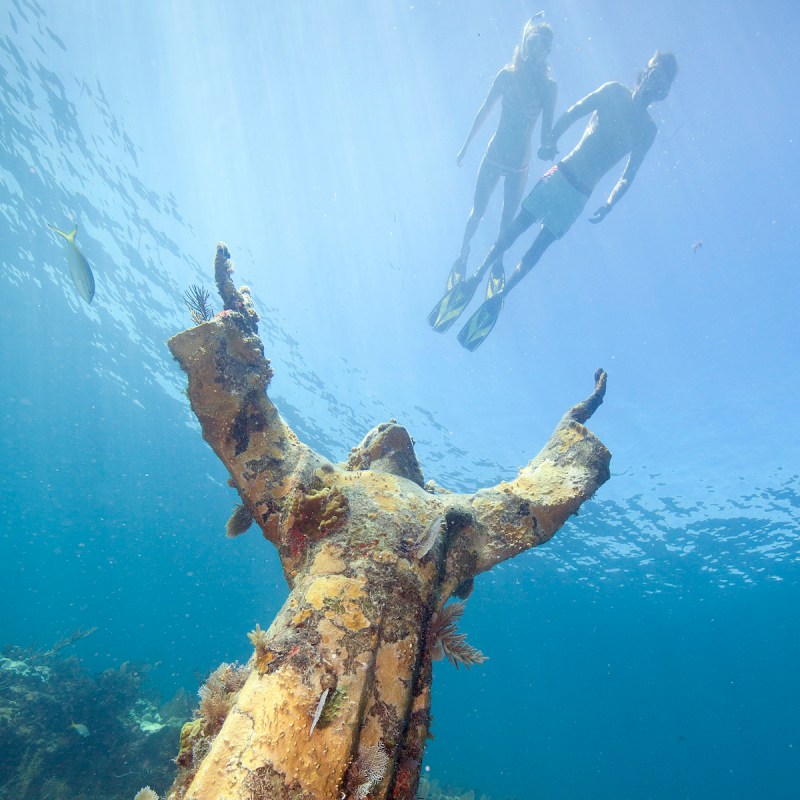
The string of subtropical islands stretching 125 miles west from Florida between the Gulf of Mexico and the Atlantic Ocean are known as the Florida Keys.
Videos by TravelAwaits
Many people do not realize that the Keys are home to ten state parks. Each has something unique to offer and provides expansive scenery and wide-open spaces. It is easy to find some solitude in all the parks, and the outdoor recreational activities are plentiful.
Some of the best and most secluded beaches are found in Florida’s state parks. The state parks in the Keys are rich with fascinating Florida Keys history, underwater sea life, and coastal landscapes.
Each park is only footsteps from Florida Bay’s aquamarine waters to the west and the turquoise hues of the Atlantic Ocean to the east. Let’s look at the various highlights of each of the state parks that the Keys have to offer.
Note: Florida Keys & Key West hosted my stay in the Keys. All opinions are my own.

1. Dagny Johnson Key Largo Hammock Botanical State Park
Key Largo, Mile-Marker (MM) 106
Dagny Johnson Key Largo Hammock Botanical State Park is the northernmost park in the Keys. It has one of the United States’ most extensive tracts of West Indian tropical hardwood hammock. At 2,805-acres, it has more than 6 miles of shaded and often paved trails, accessible to both bikes and wheelchairs.
Eighty-four protected species call this state park home. A self-guided nature trail includes signs with information regarding the ecosystem and wildlife in the park.
Tips:
- Be aware that tidal saltwater may cover parts of the trail.
- Take insect repellent and wear long sleeves and pants due to mosquitoes.
- There is an entrance fee, and you must have the correct change.

2. John Pennekamp Coral Reef State Park
Key Largo, MM 102.5
Key Largo’s John Pennekamp Coral Reef State Park was the first undersea park in the United States, and it encompasses about 70 nautical square miles.
The coral reefs and marine life bring most visitors to the park. You can enjoy the view of the reef from a glass-bottom boat tour or get a closer look by snorkeling or scuba diving. The Christ of the Abyss (or Christ of the Deep) statue is located at Key Largo Dry Rocks.
There is also kayaking, paddle boarding, and fishing. Visitors can walk on short trails and swim at the beach.
RV owners and tent campers will enjoy the 47 full-facility campsites.
Tips:
- Beach wheelchairs are available without cost.
- If you plan to fish, saltwater fishing licenses are required. (This is true for all parks in the Keys.)
3. Windley Key Fossil Reef Geological State Park
Islamorada, MM 84.9
Formed by fossilized coral called the Key Largo Limestone, Windley Key Fossil Reef Geological State Park is a 300-acre park whose quarry was used to produce exquisite pieces of decorative stone, known as Keystone, until the 1960s.
The land was owned by the railroad, which used the stone in building the Florida Keys Over-Sea Railroad.
When visiting the park, you can walk along eight-foot-high quarry walls and see cross-sections of ancient coral as you learn about the quarry and the part it played in Florida’s history.
Winding through a fossilized reef, you will find a little over a mile of trails. There are five short self-guided tours.
Tips:
- Conditions are often hot and sometimes buggy.
- Picnic tables are available, but most do not have shade.

4. Lignumvitae Key Botanical State Park
Islamorada, MM 77.2
In 1919, a wealthy Miami chemist, William Matheson, purchased the tiny island of Islamorada and built a home that included a windmill for electricity and a cistern for rainwater. This 287-acre park, known as Lignumvitae Key Botanical State Park, offers a rare look at island-style living in the Upper Keys during the 1930s. The hideaway he built is currently the visitor center on the island.
The only way to get to this state park is by boat or kayak. (Rentals from Islamorada operators.) The island is home to protected insects, birds, and endangered plants. There are also some mysterious ruins and Native American cultural sites.
Tips:
- If planning to visit, choose a day with mild winds.
- Leave a float plan that includes your destination and planned return time with someone.
- Wear clothes and a hat that provides sun protection. Fabrics that are lightweight and quick-drying are best.
- Pack food, water, and a garbage bag for any trash.
- No pets are allowed.
5. Indian Key Historic State Park
Islamorada, MM 78.5
Another park only accessible by boat, Indian Key Historic State Park, is an eight-acre island developed by John Jacob Houseman.
In the 1800s, it was the site of a wrecking empire of salvaged cargo from shipwrecks. Housman’s empire included dwellings, a store, cisterns, a hotel, and warehouses. It became the Keys’ second-largest community for a while and the first Dade County seat in 1836.
Native Americans attacked the island in 1840, and all the structures on Indian Key except one building were destroyed. Only one stone foundation remains.
Visitors enjoy sunbathing, swimming, fishing, and hiking on the island.
Due to storm damage, the boat ramp is closed. The only way to currently visit is via kayak. Watch for dolphins and manatees during your journey to and from the island.
Tip: Swim at your own risk. There are no lifeguards.
6. San Pedro Underwater Archaeological Preserve State Park
Islamorada, MM 85.5
The San Pedro, a 287-ton Dutch-built ship that sank in 1733 sits encased in coral, stones, and ballasts off Indian Key. It is the highlight of the San Pedro Underwater Archaeological Preserve State Park.
In only 18 feet of water, the San Pedro is a perfect location for beginning scuba divers or snorkelers to enjoy a fun day on the water. Over ten different species of coral and 65 species of fish have been documented on the site.
Tips:
- Be sure to bring lots of fluids and sunscreen when visiting this park.
- This is an excellent site for underwater photographers.

7. Long Key State Park
Long Key, MM 67.4
In the early 20th century, Long Key State Park was once a favored luxury destination for the rich and famous. It was destroyed in 1935 by a Labor Day hurricane, and it never reopened.
Long Key is now a tranquil haven for swimming, bird-watching, kayaking, snorkeling, fishing, or simply relaxing on the beach. There are two hiking trails to explore. A designated location on the Great Florida Birding and Wildlife Trail, you may see some rare birds. I recommend kayaking along the natural shoreline in the clear, shallow waters. Bring your kayak or rent from the ranger station.
Covered pavilions with tables for picnics are located near the water. This beautiful state park also offers primitive camping along the Atlantic Ocean.
This state park has many accessible amenities, including ramps and beach wheelchairs.
Tips:
- Restrooms have cold outdoor showers only.
- Pets are welcome.
- There are several geocaches on the island.
- The park is an excellent place for stargazing.
8. Curry Hammock State Park
Marathon, MM 56.2
Curry Hammock State Park is a 1,000-acre park in Marathon with miles of natural coastline. It sits halfway between Key Largo and Key West. It is an ideal place to paddle board, kiteboard, and kayak in secluded, protected waters.
Hikers will enjoy the 1.5-mile-long nature trail. Bicycles are welcome on roads and the Florida Keys Overseas Heritage Trail, providing easy access to and from Marathon.
Areas are designated for swimming and snorkeling.
There are 28 sites available for RV and tent camping. Restrooms include solar-powered hot showers.
A picnic area with a playground is available.
Tips:
- Helmets are recommended for all cyclists.
- No motorized boats are allowed.
- Leashed pets are welcome.

9. Bahia Honda State Park
Big Pine Key, MM 37
An award-winning beach with soft sand, warm, shallow water, and excellent snorkeling make this 500-acre park in the Lower Keys a top family getaway. Bahia Honda State Park also has campsites, cabins, and concession operations.
When the famed Over-Sea Railroad was completed in 1912, it helped to transform the remote Bahia Honda Key island into a popular tropical destination. The Over-Sea Railroad Bridge provides stunning views, and visitors are welcome to hike to part of the original trestle railroad structure.
Bahia Honda State Park is a nesting ground for sea turtles and great for bird watching. The park has beaches on both the Gulf of Mexico and the Atlantic Ocean. You can enjoy magnificent sunsets, balmy sea breezes, clear waters, and palm-lined beaches.
There are snorkeling excursions available, and you can also rent kayaks and snorkeling gear. You may see soft corals, small coral heads, and tropical fish.
You can ride bicycles on the park’s paved roads only.
The camping sites available on the oceanside accommodate large RVs. All have water, a picnic table, a grill, and electricity. The camping sites on the bayside are non-electric.
Tips:
- If camping, please note the sites on the water have little shade.
- Campers must fit under the Bahia Honda Bridge (six feet, eight inches).
- Pets must be leashed.
- Avoid swimming near the Bahia Honda Channel due to swift currents.

10. Fort Zachary Taylor Historic State Park
Key West
Florida’s southernmost state park is the 56-acre Fort Zachary Taylor Historic State Park. Built in the mid-1800s, Fort Zachary Taylor was one of 47 forts constructed to defend the nation’s southeastern coastline.
This National Historic Monument houses the most extensive collection of Civil War armament in the world. Interpretive panels explain how the fort played important roles in the nation’s history. On the third weekend of every month, re-enactments and historic demonstrations occur as part of the living-history program.
The shallow and clear water around Fort Zachary offers excellent swimming and snorkeling in the Keys. There are concession stands with food and refreshments, plus a gift shop.
Biking is permitted along the shore past the fort and beside the Key West Shipping Channel.
The park operates as a day park from 8 a.m. till sunset each day.
Wondering what it looks like? Check out the live beach cam and enjoy the view.
Most amenities at Fort Zachary are accessible, and beach wheelchairs are available at no cost.
Tips:
- Water shoes are recommended if you plan to enter the water.
- Snorkeling equipment available for rent at the concession stand.
- There are no lifeguards on duty.
You can find more information about each park and about the Florida State Park Pass that provides free entry into all the state parks on the Florida State Parks website.
You can learn more about the Florida Keys and the parks on the visitor information site.
